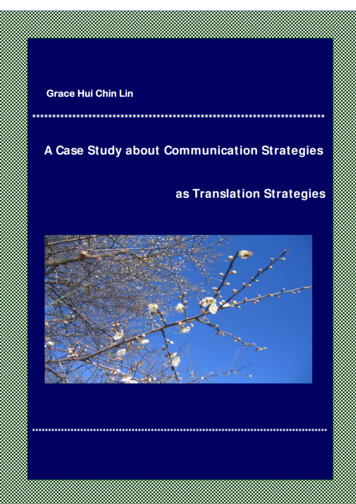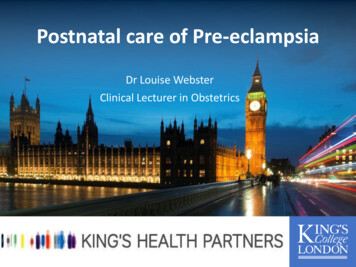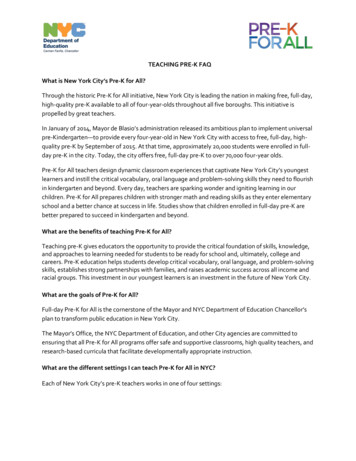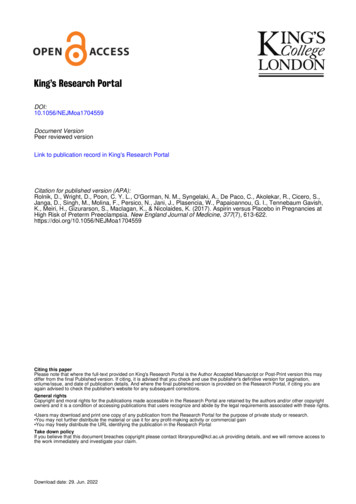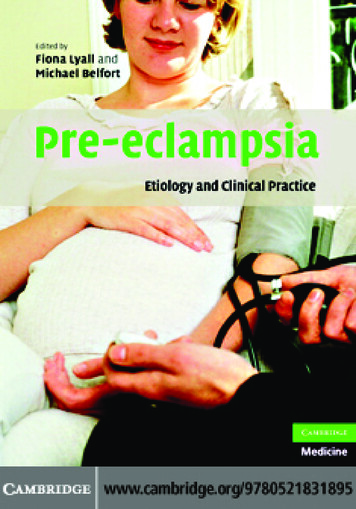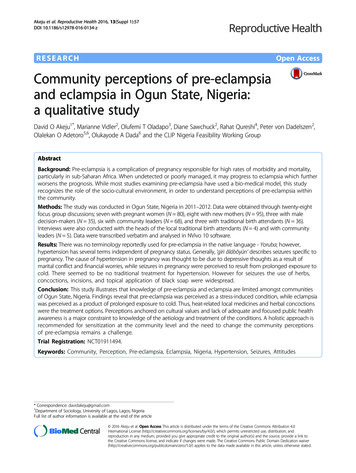
Transcription
Akeju et al. Reproductive Health 2016, 13(Suppl 1):57DOI 10.1186/s12978-016-0134-zRESEARCHOpen AccessCommunity perceptions of pre-eclampsiaand eclampsia in Ogun State, Nigeria:a qualitative studyDavid O Akeju1*, Marianne Vidler2, Olufemi T Oladapo3, Diane Sawchuck2, Rahat Qureshi4, Peter von Dadelszen2,Olalekan O Adetoro5,6, Olukayode A Dada6 and the CLIP Nigeria Feasibility Working GroupAbstractBackground: Pre-eclampsia is a complication of pregnancy responsible for high rates of morbidity and mortality,particularly in sub-Saharan Africa. When undetected or poorly managed, it may progress to eclampsia which furtherworsens the prognosis. While most studies examining pre-eclampsia have used a bio-medical model, this studyrecognizes the role of the socio-cultural environment, in order to understand perceptions of pre-eclampsia withinthe community.Methods: The study was conducted in Ogun State, Nigeria in 2011–2012. Data were obtained through twenty-eightfocus group discussions; seven with pregnant women (N 80), eight with new mothers (N 95), three with maledecision-makers (N 35), six with community leaders (N 68), and three with traditional birth attendants (N 36).Interviews were also conducted with the heads of the local traditional birth attendants (N 4) and with communityleaders (N 5). Data were transcribed verbatim and analysed in NVivo 10 software.Results: There was no terminology reportedly used for pre-eclampsia in the native language - Yoruba; however,hypertension has several terms independent of pregnancy status. Generally, ‘gìrì âlábôyún’ describes seizures specific topregnancy. The cause of hypertension in pregnancy was thought to be due to depressive thoughts as a result ofmarital conflict and financial worries, while seizures in pregnancy were perceived to result from prolonged exposure tocold. There seemed to be no traditional treatment for hypertension. However for seizures the use of herbs,concoctions, incisions, and topical application of black soap were widespread.Conclusion: This study illustrates that knowledge of pre-eclampsia and eclampsia are limited amongst communitiesof Ogun State, Nigeria. Findings reveal that pre-eclampsia was perceived as a stress-induced condition, while eclampsiawas perceived as a product of prolonged exposure to cold. Thus, heat-related local medicines and herbal concoctionswere the treatment options. Perceptions anchored on cultural values and lack of adequate and focused public healthawareness is a major constraint to knowledge of the aetiology and treatment of the conditions. A holistic approach isrecommended for sensitization at the community level and the need to change the community perceptionsof pre-eclampsia remains a challenge.Trial Registration: NCT01911494.Keywords: Community, Perception, Pre-eclampsia, Eclampsia, Nigeria, Hypertension, Seizures, Attitudes* Correspondence: davidakeju@gmail.com1Department of Sociology, University of Lagos, Lagos, NigeriaFull list of author information is available at the end of the article 2016 Akeju et al. Open Access This article is distributed under the terms of the Creative Commons Attribution 4.0International License (http://creativecommons.org/licenses/by/4.0/), which permits unrestricted use, distribution, andreproduction in any medium, provided you give appropriate credit to the original author(s) and the source, provide a link tothe Creative Commons license, and indicate if changes were made. The Creative Commons Public Domain Dedication o/1.0/) applies to the data made available in this article, unless otherwise stated.
Akeju et al. Reproductive Health 2016, 13(Suppl 1):57BackgroundPre-eclampsia is one of the most common complicationsof pregnancy and continues to be a leading cause ofdeath and disability globally [1]. Pre-eclampsia is characterized by new onset of hypertension and proteinuriaafter 20 weeks gestation [2]. It may progress to eclampsia; a potentially lethal complication characterized byconvulsions requiring an emergency response [3]. TheWorld Health Organization estimates that 14 % of allmaternal deaths result from the hypertensive disorders ofpregnancy (HDP); it is also associated with a high risk ofnewborn death [1]. Nigeria, has one of the highest maternal mortality ratios ranging from 496 to 560 per 100,000live births [4, 5], as well as a high prevalence of preeclampsia and eclampsia of between 2 % to 16.7 % [6].Most studies focussing on pre-eclampsia and eclampsia have used a bio-medical model to examine causativefactors, prevention and treatment without much attention to local perceptions. This study takes an alternateapproach by adopting a perspective that recognizes aninteraction of various components of the socio-culturalenvironment that influence community perceptions [7].The aetiology of pre-eclampsia remains a mystery; thecause and disease pathways are not fully understood[8]. There is a gap in knowledge regarding the causesamong communities in Northern Nigeria where preeclampsia is believed to be caused by Iska (spirits) [9].Similarly, Nigerian men have reported that maternaldeaths are caused by supernatural spirits, social andeconomic factors, or poor quality health care services[10]. Some Nigerians did not recognize the signs ofpre-eclampsia; however, some women recognizedeclampsia and hypertension as potential causes ofmaternal mortality [11, 12].The aim of this study was to identify community perceptions of pre-eclampsia and eclampsia in Ogun State,Nigeria. These community understandings were described by the use of local terms, perceived causes, prevention strategies, known outcomes and traditionaltreatments.MethodsDescription of study sitesThe study was undertaken in Nigeria, the country withthe largest population in Africa and the 14th largest inland mass [4]. More specifically, it was conducted infour (Ogijo, Yewa South, Imeko-Afon and Remo North)Local Government Areas (LGAs) in Ogun State, locatedin south-western Nigeria. The predominant ethnic groupis Yoruba. The health status of the region is reflective ofthat of most of south-western Nigeria [4]. There are highrates of poverty, fertility and mortality [4]. See Table 1for country and cluster characteristics, see Fig. 1 for amap of study areas.Page 18 of 97Table 1 Study site characteristicsNigeria characteristicsPopulation159,288,426Size (Km2)923, 768Number of states36Number of geopolitical zones6Predominant languageYoruba, Igbo, and HausaPredominant religionsChristianity and IslamOgun State characteristicsPopulation4,000,0002Size (Km )16,409Number of local government areas20Predominant languageYorubaPredominant religionChristianityLocal Government Area characteristicsCumulative population2469,271Cumulative size (Km )1657Number of study areas4/40Data collectionData were collected as part of a larger community-basedassessment of the acceptability of community-based treatment for pre-eclampsia and eclampsia in Nigeria: a detailed description of these methods is published elsewhere[13]. Focus group discussions and in-depth interviewswere conducted from 2011-to-2012.Eight focus groups were held with pregnant women(N 94), eight with new mothers (N 95), four withmale decision-makers (N 47), five with communityleaders (religious and representatives of traditional rulersand political groups) (N 56), and three with traditionalbirth attendants (TBAs) (N 36). In addition, interviewswere conducted with the heads of the traditional birthattendants (N 4) and with community leaders (N 5).Data analysisAll in-depth interviews and focus group discussionswere transcribed and translated from local language(Yoruba) to English. These translations were reviewedby study investigators to ensure accuracy, and validated with field notes. Data were analysed using QSRNVivo version 10 software. The analytical frameworkand coding structure were developed by the studyprincipal investigators (FO, OA) and data analyst(MV); however, for consistency, all coding was performedby one individual (MV). In addition, the nodal structurecreated and used for coding was subjected to a thoroughreview process by five other authors prior to the commencement of the coding exercise. The majority ofthemes were identified a priori to represent communityperceptions of pre-eclampsia; however, a small number of
Akeju et al. Reproductive Health 2016, 13(Suppl 1):57Page 19 of 97Fig. 1 Map of study sitesthemes emerged from the data through the coding processand were included at that time (Fig. 2).The Health Research and Ethics Committee of OlabisiOnabanjo University Teaching Hospital, Sagamu, Nigeria(OOUTH/DA/326/431), and the Clinical Research EthicsBoard of the University of British Columbia, Vancouver,Canada (H12-00132), approved the study.ResultsDemographic characteristics were collected during focusgroups discussions on all 323 participants; for details ofparticipants see Tables 2. Nearly all participants weremarried; there were very few exceptions to this. Participants were of Islamic, Christian, and local traditionalfaiths; however, Christianity predominated. Most participants had at least one child with several having up to 7children. Educational attainment was highest in onecluster (Ogijo); this may be explained by its proximity toan urban centre (Tables 2 and 3).Local terms for pre-eclampsia and eclampsiaBased on the descriptions provided by respondents, preeclampsia and eclampsia appeared to be a common occurrence in these communities. Although, hypertensionand convulsions had few local names that are independent of pregnancy status, there were no local terms inYoruba for pre-eclampsia.Hypertension in pregnancy was commonly referred toas “èjè rírû” or “ìfúnpá gígâ”. The term “ìfúnpá gígâ” inYoruba, is a combination of two words: “ìfúnpá” signifiesthe process of strapping the arm during a blood pressuremeasurement and “gígâ” refers to something “elevated”or “high”. Thus, “ìfúnpá gígâ” as a local term was usedto describe hypertension. On the other hand, “èjè ríru”provides a succinct description of hypertension; it literally means “stormy blood”. This term captures the localperception that hypertension is comparable to a stormwithin the body.A number of participants used local terms for generalconvulsions or convulsions in children to describe
Akeju et al. Reproductive Health 2016, 13(Suppl 1):57Page 20 of 97PreventionstrategiesPerceivedcausesLocal termsPerceivedconsequencesCommunityperceptions ofpre-eclampsiaand eclampsiaTraditionaltreatmentsFig. 2 Thematic categories used in analysiseclampsia: “gìrì” and “àìsàn îlè tútù”. “Gìrì” is a commonlocal term used to describe the temporary jerking of thebody. “Àìsàn îlè tútù” is used to represent seizures, whichtranslates to ‘cold-ground illness’; this indicated the perceived relationship between exposure to cold and seizures.Though these terms imply general convulsions, many alsoreported the use of ‘gìrì âlábôyún’ which is specific topregnancy and represents eclampsia (See Table 4 for a listof these local names).Perceived causes of pre-eclampsia and eclampsiaThere was a consensus amongst the community regarding what was believed to cause hypertension in pregnancy; most often depressive thoughts and stress weredescribed as the origin.“If the pregnant woman is having depressive thoughts,if she encounters something that is beyond her, and shebegins to worry about the issue, a thing like that couldcause high blood pressure.” [Pregnant Woman]The root of these depressive thoughts was mostoften related to marital or financial worries. Thismarital conflict included abandonment, teenage pregnancies, unfaithful partners and lack of adequate careby the husband.“It is caused by their husband’s bad behaviour, becausea lot of men want their wives and not her pregnancy.Some husbands would stop taking care of their wiveswhen they become pregnant.” [Community Leader]Depressive thoughts were also believed to be associated with a lack of rest which could cause hypertension.Most respondents in this study did not believe thathypertension could have a spiritual origin; however asmall number maintained this belief.Although a number of possible causes for eclampsiaemerged from focus group discussions and in-depth interviews, the most common were the influences of cold, heredity, diet, and depressive thoughts or stress. There was astrong perception that taking cold food, or drinks duringpregnancy can lead to convulsions, as well as the exposureto cold weather. This was by far the most common explanation of convulsions in pregnancy in the community.A pregnant woman demonstrates this belief in the following quote:“There is a belief that if a pregnant woman frequentlysleeps on a cold floor, it could cause convulsion, or ifthe body is exposed to too much breeze [ ] and alsoif there are excessive depressive thoughts it can leadto convulsion.” [Pregnant Woman]Another explanation was that convulsions during pregnancy could be hereditary.“Something that I have noticed about ‘gìrì’ is thatsome things are hereditary. There are some things thatpeople would say similar thing happened to the fatheror mother at a time. So things like this would havebecome hereditary and if this is not treated early itwill run from two to three generations and it wouldbecome a family problem.” [Community Leader]Similar to the causes of hypertension, development ofseizures in pregnancy were seen to be caused by depressive thoughts and stress (See Table 5 for a list of causesmentioned). One male decision-maker shared his viewabout how depressive thoughts could lead to convulsion:
Akeju et al. Reproductive Health 2016, 13(Suppl 1):57Page 21 of 97Table 2 Focus group discussion characteristics#N participantsRegionAge (yr) median[range]Religion1 IslamN childrenmedian [range]% Married5 [0, 6]100 %Not known100 %2 Christian3 Traditional religionCommunity leaders112Yewa South52 [27, 70]210Remo North44 [43, 77]1 (N 6)2 (N 6)1 (N 3)2 (N 5)3 (N 2)312Remo North58 [30, 85]Not knownNot known100 %410Ogijo50 [26, 71]1 (N 5)6 [1, 9]100 %512Ogijo57 [45, 72]8 [4, 10]100 %3 [0,10]100 %3 [1, 5]100 %3 [0, 9]100 %6 [4, 10]100 %3 [1, 5]100 %2 [1, 3]100 %4 [1, 6]100 %2 [1, 4]100 %3 [1, 4]92 %2 [1, 5]100 %3 [1, 5]100 %3 [1, 6]100 %1 [0, 4]100 %2 (N 5)1 (N 3)2 (N 6)3 (N 3)612Imeko-Afon45 [20, 55]1 (N 6)2 (N 6)Male decision-makers112Yewa South38 [27, 49]211Remo North40 [35, 62]1 (N 2)2 (N 10)1 (N 4)2 (N 6)3 (N 1)312Imeko-Afon51 [40, 60]1 (N 11)2 (N 1)New mothers112Yewa South27 [20, 42]212Yewa South31 [20, 42]312Remo North29 [21, 39]412Remo North28 [21, 34]512Ogijo31 [26, 43]612Ogijo29 [22, 38]712Imeko-Afon30 [16, 36]811Imeko-Afon30 [18, 36]1 (N 6)2 (N 6)1 (N 4)2 (N 8)1 (N 3)2 (N 9)1 (N 5)2 (N 7)1 (N 4)2 (N 8)1 (N 1)2 (N 11)1 (N 5)2 (N 7)1 (N 6)2 (N 5)Pregnant women112Yewa South26 [20, 33]1 (N 3)
Akeju et al. Reproductive Health 2016, 13(Suppl 1):57Page 22 of 97Table 2 Focus group discussion characteristics (Continued)2 (N 9)212Yewa South26 [20, 39]1 (N 4)3 [1, 3]100 %1 [1, 3]100 %3 [1, 5]100 %1 [0, 2]100 %1 [0, 4]100 %2 [0, 4]100 %3 [1, 4]100 %5 [3, 5]100 %4 [0, 5]83 %2 (N 8)312Remo North30 [20, 36]1 (N 1)2 (N 11)412Remo North32 [23, 40]1 (N 5)2 (N 7)59Ogijo27 [19, 34]1 (N 6)2 (N 3)610Imeko-Afon22 [19, 26]1 (N 7)2 (N 3)712Imeko-Afon25 [20, 30]1 (N 2)2 (N 10)Traditional birth attendants112Yewa South44 [32, 65]212Remo North50 [41, 77]1 (N 7)1 (N 5)1 (N 1)2 (N 8)3 (N 2)312Ogijo40 [25, 50]1 (N 5)2 (N 6)“If she’s under too much stress, she might not sleep andit gets to the point that she finds it difficult to sleepand the health care workers begin to monitor herblood pressure, a thing like this could cause convulsionfor an adult and it’s the same predicament for apregnant woman” [Male Decision-Maker]Similarly, a number of respondents perceived the roleof diet to be important in the development of seizures.Poor diet was rarely stated as an independent contributor, but rather a co-factor with marital problems orfinancial constraints. Apart from the causes mentionedabove, the medical conditions thought to be related toTable 3 Interview characteristicseclampsia were anaemia, malaria, urinary tract infections,diabetes, infections, oedema, pre-existing hypertension,and the lack or loss of blood. The possibility of a spiritualorigin for convulsions in pregnancy was widely discreditedby the community. Some participants showed comprehension that high blood pressure is a cause of convulsions;however, most did not associate the two conditions.“What causes convulsion is like the other participantexplained earlier, if a pregnant woman should havehigh blood pressure there would be a substance inher urine, there’s a way they detect the substance, alsoif her legs are swollen blood shortage could causeswollen legs for the pregnant woman, lack of blood inher system could make her legs to swell. If a womanshould stress herself too much during pregnancy athing like this could make her develop high bloodpressure, all these factors together would causeconvulsion for the pregnant woman and the conditionwould be out of control. [Community Leader]#Stakeholder groupCluster1Head of traditional birth attendantsSagamu2Head of traditional birth attendantsYewa South3Head of traditional birth attendantsImeko-Afon4Head of traditional birth attendantsRemo North5Community leaderImeko-AfonPrevention strategies for pre-eclampsia and eclampsia6Male community leadersImeko-Afon7Women community leadersSagamu8Women community leadersImeko-Afon9Women community leadersRemo NorthMuch of the preventive practices mentioned were relatedto pre-eclampsia and centred on the type and quality ofcare women received during pregnancy. There were a fewmentions of local or traditional practices for prevention ofpre-eclampsia aside from dietary suggestions. The role of
Akeju et al. Reproductive Health 2016, 13(Suppl 1):57Page 23 of 97Table 4 Local terms for pre-eclampsia and eclampsiaLocal terms for pre-eclampsiaÌfúnpá gígâÈjè rírû (stormy blood)Local terms for eclampsiaGìrì âlábôyún(pregnancy-relatedseizure)Gìrì (Seizure)Gìrì àgbàlâgbà(Seizure in adults)Gìrì ipa (stubbornseizure)Gìrì înú ôyún(pregnancy-related seizure)Òyì ôrí (dizzinessin the head)Îpá ná (Hot seizure)Îlè tútù (cold ground)Òyì ôjú (dizzinessin the eyes)men in the prevention of pre-eclampsia was widely emphasized, particularly the importance of their emotionaland financial support.“If a pregnant woman has a history of convulsion andher husband is aware of her condition her husbandcould find a person that would be assisting his wife, hewould tell the person that “in case my wife convulses,please you would help me assist her” and when theysee that the pregnant woman is heavy and she’s aboutto deliver they shouldn’t let her be alone, theyshouldn’t allow her to be alone.because it could affecther pregnancy.” [New Mother]In addition to the role of men, diet was perceived as asignificant moderator of high blood pressure. Decreasedintake of ‘maggi’ – a common food seasoning - and saltwere thought to be appropriate methods for preventinghigh blood pressure among pregnant women. Other prevention strategies included a public health enlightenmentprogramme on preventive methods of pre-eclampsia andits management at the community level. In addition, theroles of community health workers in expanding knowledge and creating awareness on pre-eclampsia andeclampsia conditions was perceived to be very crucial.Outcomes of pre-eclampsia and eclampsiaThere was a general perception that pre-eclampsia is severe and could lead to loss of life in pregnancy. This wasreinforced by individual experiences of pre-eclampsia.One male decision-maker gave a description of high bloodpressure in pregnancy as “a trap”.“High blood pressure is like a trap, once it affects awoman, it may be difficult to cure. Sometime it maybe hereditary and once a woman has it, she can alsotransfer it to her unborn baby since they both sharethe same blood, high blood pressure can lead to thedeath of women.” [Male Decision-Maker]Furthermore, a view expressed among a segment ofthe population showed that “high blood pressure canaffect the brain [and] it can also lead to “gìrì” (convulsions), or “òyì orí” (dizziness). The term “òyì orí” combines two Yoruba words; “òyì” literally means dizziness,while “orí” refers to head. Thus, “òyì orí” signifies dizzinessin the head which could lead to a fatal fall. TBAs described convulsions in pregnancy as a complicated condition. One TBA explained that “gìrì ipá” (convulsions)could lead to “âbísíwín”, known as puerperal psychosis inbiomedical terms. According to new mothers, possibleoutcomes of pre-eclampsia and eclampsia were prematurebirth, stillbirth, paralysis, and stroke.Traditional treatment of pre-eclampsia and eclampsiaTable 5 Perceived causes of pre-eclampsia and eclampsiaPerceived causes of pre-eclampsiaDepressive thoughtsHereditaryStressPerceived causes of eclampsiaProlonged exposure to coldHypertensionAnaemiaMalariaUrinary tract infectionsDiabetesOedemaLack or loss of bloodPre-existing hypertensionTaking cold food or drinksSleeping on a cold floorHome-based and traditional treatments for pregnancycomplications were very common in the region. Therewere many traditional treatments used for eclampsia including eating onion, drinking salt solution, and applyingRobb to the chest. Robb is a type of balm used for relievingaches and pains among children and adults in addition toits use for treating cold and shivering condition. Other traditional treatment options mentioned were bodily incisionsand prayers. According to one woman, “they could give thepregnant woman onions, they should shred the onions andput in it in her mouth, the aroma of the onions would calmher down, before they take her to the hospital”. As eclampsiawas believed to be caused by exposure to cold, a concoction known as “oògùn ilè tútù” meaning cold ground medicine was widely reported as one of the traditionalmedicines used. The role of cold-ground-medicine ishighlighted in the following quote by a pregnant woman:“If it (convulsion) happens, the woman would be givena local concoction “oògùn ilè tútù” or would be taken
Akeju et al. Reproductive Health 2016, 13(Suppl 1):57to the hospital. But she would usually be given thelocal concoction until the convulsion subsides.”[Pregnant Woman]In the treatment of eclampsia, some put salt in thepregnant woman’s mouth as it is believed “salt woulddissolve the substance blocking the blood vessels”. Inaddition to giving salt, a spoon or ‘chewing stick’ is ofteninserted into the mouth to avoid clenching the teeth.Other types of treatment include asking the woman tolie down on her right side, and then pouring water onher head until she is revived.“They should turn her to her right side and raiseher up that is what I know and that is what I’vewitnessed, if they pour water on her head and raiseher up and put her down gently. Nobody should say aword around her at that moment. If it’s just a normalconvulsion, she would be revived.” [New Mother]Lime and hot spices were also reportedly used fortreating eclampsia. A TBA described the contents of oneof the local concoctions used for eclampsia:“I use original tobacco leaves use it with boilingwater and soak it with lemon juice, if pregnant womanis convulsing give her one teaspoon, rub it on her eyesand body it will usually calm her down.”[Traditional Birth Attendant]Some opinion leaders reported the use of incisions onthe forehead or abdomen of pregnant women for treatingeclampsia. This was usually combined with other localitems such as black soap, concoctions, and burnt leaves.“They treat it in the traditional way, using [herbs],black soap, burnt leaves or make incisions. You wouldsee some pregnant women with many incisions ontheir heads.” [Community Leader]Among those who patronized prayer houses and spiritualists, different treatment methods were reported: holywater. In addition, a special prayer session was reportedlycarried out for these women.DiscussionThe findings of this study show that community perceptions of pre-eclampsia and eclampsia in Ogun State differ significantly from biomedical perspectives [9]. Whilethe perceived cause of eclampsia in these communitieswas exposure to cold, biomedical evidence suggests thatthe causal pathway is related to abnormal placentation[14]. Divergent community perspectives reported in thisstudy have led to treatment in line with traditionalPage 24 of 97norms and values in Ogun State, Nigeria. Local treatments in these communities have stemmed from thecommunity’s understanding of the condition.In addition, the findings show that respondents do notuse specific terms for pre-eclampsia in local language,though hypertension has names that independent ofpregnancy status that are used. These results demonstrate limited knowledge and awareness of pre-eclampsiaand its associated consequences despite its rating as oneof the leading causes of maternal death [1, 2, 15, 16].There was consensus amongst the community on thecauses of hypertension, both during and outside pregnancy, with the main cause pointing to psychologicalfactors, particularly depressive thoughts, heredity andstress. There was a similar consensus regarding the causeof eclampsia, the origin reportedly related to an exposureto cold. These findings further show that a knowledge gapexists regarding the causes and progression of symptomsfrom pre-eclampsia to eclampsia. This lack of awarenessunderscores the need for a sustained commitment tocommunity sensitization using a combination of approaches that could penetrate social and cultural norms.There is need for further sensitization of the community members with respect to availability of subsidizedhealth services. The process for sensitization also offersopportunity for education regarding pre-eclampsia andeclampsia. There is a need to promote a strategy thatallows community members to intervene using culturalnorms to address challenges in care delivery for womenwith pre-eclampsia and eclampsia. In this sense, thisstudy advocates for a “cultural intervention”. As distinctfrom other forms of intervention, cultural interventionwill enable the community to discuss their problems andchallenges with the aim of providing solutions to them.The involvement of men in maternal health could beculturally influenced. The role of men in pregnancy anddelivery care among African women has gained attentionrecently, [17, 18] and could be extended to issues relatedto pre-eclampsia and eclampsia.This study reveals that there are several local treatments for eclampsia among community members inOgun state. The use of traditional medicine during pregnancy has been documented elsewhere [19]. The desireto have personal control over their health, dissatisfactionwith conventional treatments, and concerns about theside effects of medications explain in part the use ofherbal remedies during pregnancy [20]. The efficacy oflocal interventions, especially those related to the treatment of eclampsia is either not known or deleterious(i.e. placing items between the teeth). The use of traditional treatment has been identified as a source of delayto accessing appropriate health care services and alsocould be a marker for harmful behaviour [21]. The findings from this study provide additional information on
Akeju et al. Reproductive Health 2016, 13(Suppl 1):57local perception and practices that have consequencesfor the early treatment of pre-eclampsia and eclampsiain Nigeria.The general perception that psychological distress couldbe an underlying cause of pre-eclampsia and eclampsiarequires further exploration. This study shows that thereis a large gap between community perceptions of preeclampsia and eclampsia and the biomedical perspective.Sadly, relevant policies, like the National Health Policy inNigeria, do not take into account community perspectivesin framing such policies. As such, these policies are generally disconnected from peoples’ experiences, beliefs andlocal realities.Strengths and limitationsOne of the strengths of this study is the communitybased approach, which provided rich insight intoperceptions of the diverse population. In addition, theparticipation of the various stakeholder groups whoinfluence beliefs and attitudes enriched the studyfindings: pregnant women, opinion leaders, religiousleaders, TBAs and male decision-makers. Furthermore, amulti-disciplinary approach brought researchers fromvarious backgrounds to enhance quality in data collection.Notwithstanding, findings from this study may not applyto other ethnic groups represented in Nigeria other thanthe Yoruba among whom the study was conducted. Another limitation is the inability of the study to provide indetails regarding the contents of local medicines in useduring pregnancy.ConclusionsThe study illustrates that knowledge of pre-eclampsia andeclampsia are limited amongst communities of OgunState, Nigeria; there are gaps in knowledge regarding theaetiology and treatment of the conditions. It also highlights the need for a review of maternal health policies inNigeria with special attention to community roles, specifically the role of men, and the need for health careproviders to be equipped with appropriate skills and relevant materials to provide community education andsensitization to improve maternal and perinatal health.Additional fileAdditional file 1: Peer review reports. (PDF 274 kb)AbbreviationsHDP: Hypertensive disorders of pregnancy; LGA: Local Government Areas;TBA: traditional birth attendants.Competing interestsThe authors declare they have no competing interests.Page 25 of 97Author’s contributionsDOA developed the manuscript and oversaw data acquisition. MV a
(Yoruba) to English. These translations were reviewed by study investigators to ensure accuracy, and vali-dated with field notes. Data were analysed using QSR NVivo version 10 software. The analytical framework and coding structure were developed by the study principal investigators (FO, OA) and data analyst


